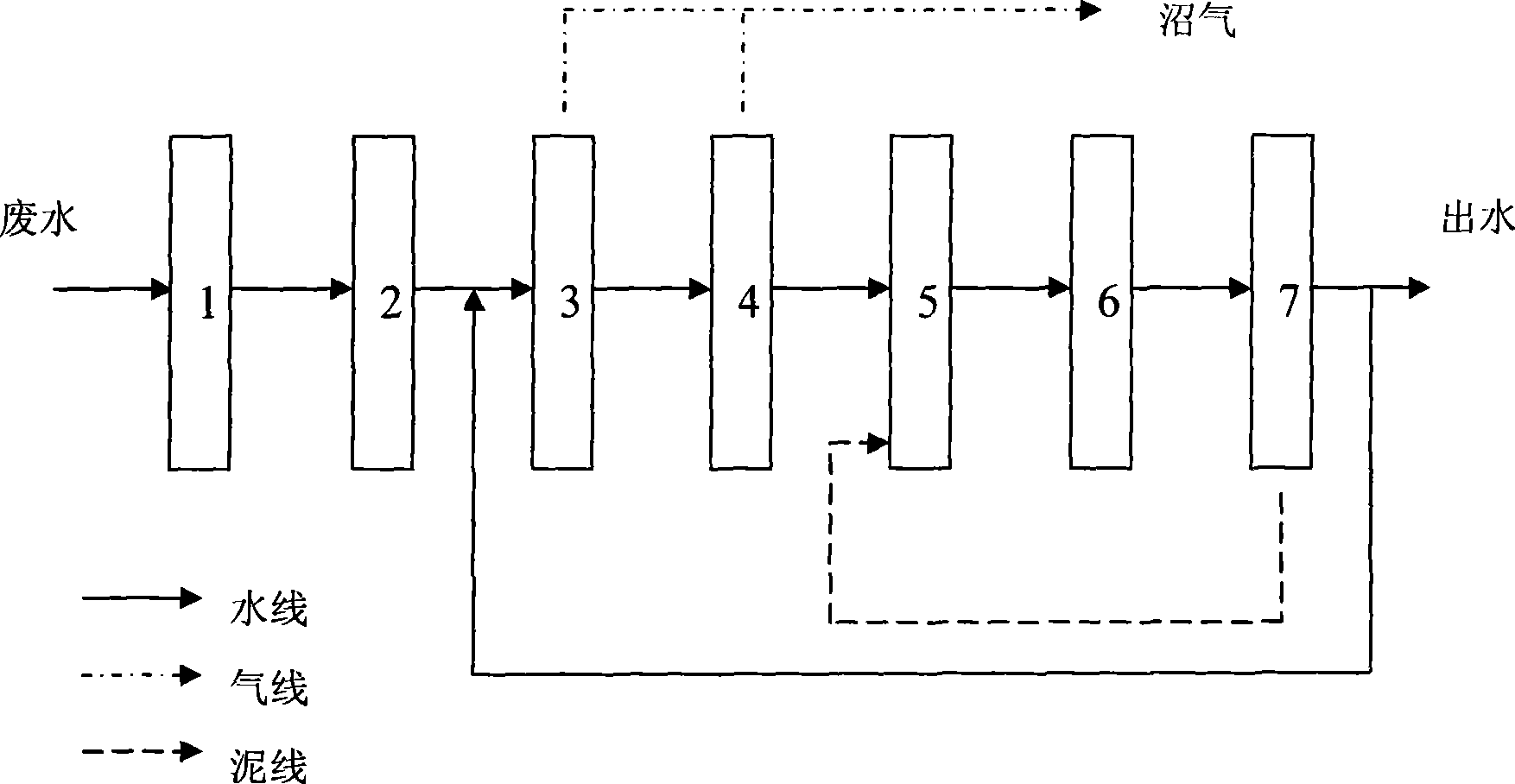Treatment method for cellulose fermentation wastewater
A technology of fermentation wastewater and treatment method, which is applied in neutralization water/sewage treatment, reduced water/sewage treatment, water/sewage multi-stage treatment, etc., can solve the problem of increasing total wastewater discharge, high equipment investment and operating costs, Waste water resources and other issues to achieve the effect of being conducive to recycling, low operating costs, and environmental protection
- Summary
- Abstract
- Description
- Claims
- Application Information
AI Technical Summary
Problems solved by technology
Method used
Image
Examples
Embodiment 1
[0033] Cellulose fermentation waste water (COD 42436mg / L) was taken for testing. Wastewater enters the iron-carbon reaction tank, the amount of iron filings is 100g / L, and activated carbon particles are added according to the iron-carbon ratio (W / W) of 1:1, the aeration rate is 50ml / min, and the reaction time is 90min. Then the wastewater enters the neutralization sedimentation tank, the pH is adjusted to 9.0, and after standing for 6 hours, it enters the hydrolysis acidification tank, and the residence time is 12 hours. Then the wastewater enters the anaerobic fermentation tank, and the pH in the control system is 6.9. After staying for 3 days, it enters the two-stage SBR The pools are treated with aerobic treatment. Each SBR pool is aerated for 8 hours and drained for 4 hours, with a residence time of 12 hours. After passing through the secondary settling tank, the residence time is 3 hours, and the water is discharged.
[0034] After the cellulose fermentation wastewater is...
Embodiment 2
[0036] Take cellulose fermentation waste water (COD58013mg / L) for experiment. The waste water enters the iron-carbon reaction tank, the amount of iron filings is 200g / L, the activated carbon particles are added according to the iron-carbon ratio (W / W) of 3:1, the aeration rate is 100ml / min, and the reaction time is 150min. Then the wastewater enters the neutralization sedimentation tank, the pH is adjusted to 9.0, and after standing for 6 hours, it enters the hydrolysis acidification tank, and the residence time is 6 hours. Then the wastewater enters the anaerobic fermentation tank, and the pH in the control system is 7.1. After staying for 8 days, it enters the two-stage SBR The pools are treated with aerobic treatment. Each SBR pool is aerated for 6 hours and drained for 2 hours, with a residence time of 8 hours. After passing through the secondary settling tank, the residence time is 4 hours, and the water is discharged.
[0037] After the wastewater is treated above, the C...
Embodiment 3
[0039] Take cellulose fermentation waste water (COD 30530mg / L) for experiment. Wastewater enters the iron-carbon reaction tank, the amount of iron filings is 50g / L, and activated carbon particles are added according to the iron-carbon ratio (W / W) of 0.5:1, the aeration rate is 200ml / min, and the reaction time is 30min. Then the wastewater enters the neutralization sedimentation tank, the pH is adjusted to 10.0, and after standing for 1 hour, it enters the hydrolysis acidification tank, and the residence time is 48 hours. Then the wastewater enters the anaerobic fermentation tank, and the pH in the control system is 6.5. After staying for 1 day, it enters the two-stage SBR The pool is subjected to aerobic treatment. Each SBR pool is aerated for 10 hours and drained for 4 hours as a cycle, with a residence time of 14 hours. After passing through the secondary sedimentation tank, the residence time is 5 hours, and the water is discharged.
[0040] After the cellulose fermentation...
PUM
 Login to View More
Login to View More Abstract
Description
Claims
Application Information
 Login to View More
Login to View More - R&D
- Intellectual Property
- Life Sciences
- Materials
- Tech Scout
- Unparalleled Data Quality
- Higher Quality Content
- 60% Fewer Hallucinations
Browse by: Latest US Patents, China's latest patents, Technical Efficacy Thesaurus, Application Domain, Technology Topic, Popular Technical Reports.
© 2025 PatSnap. All rights reserved.Legal|Privacy policy|Modern Slavery Act Transparency Statement|Sitemap|About US| Contact US: help@patsnap.com

